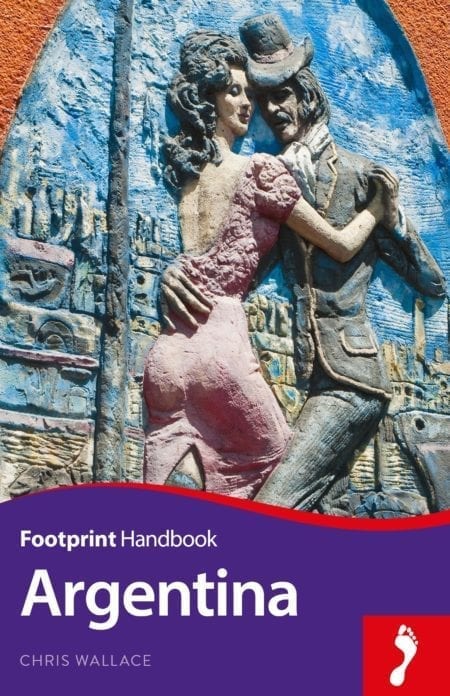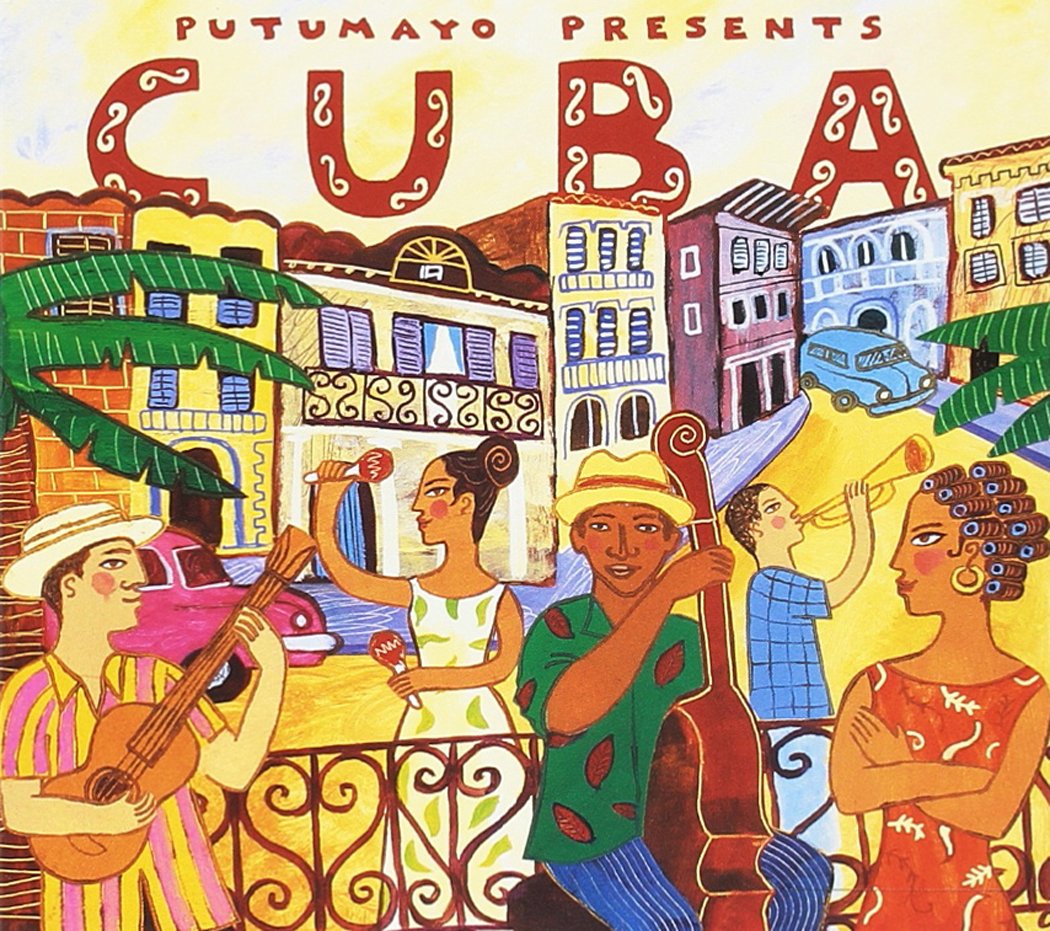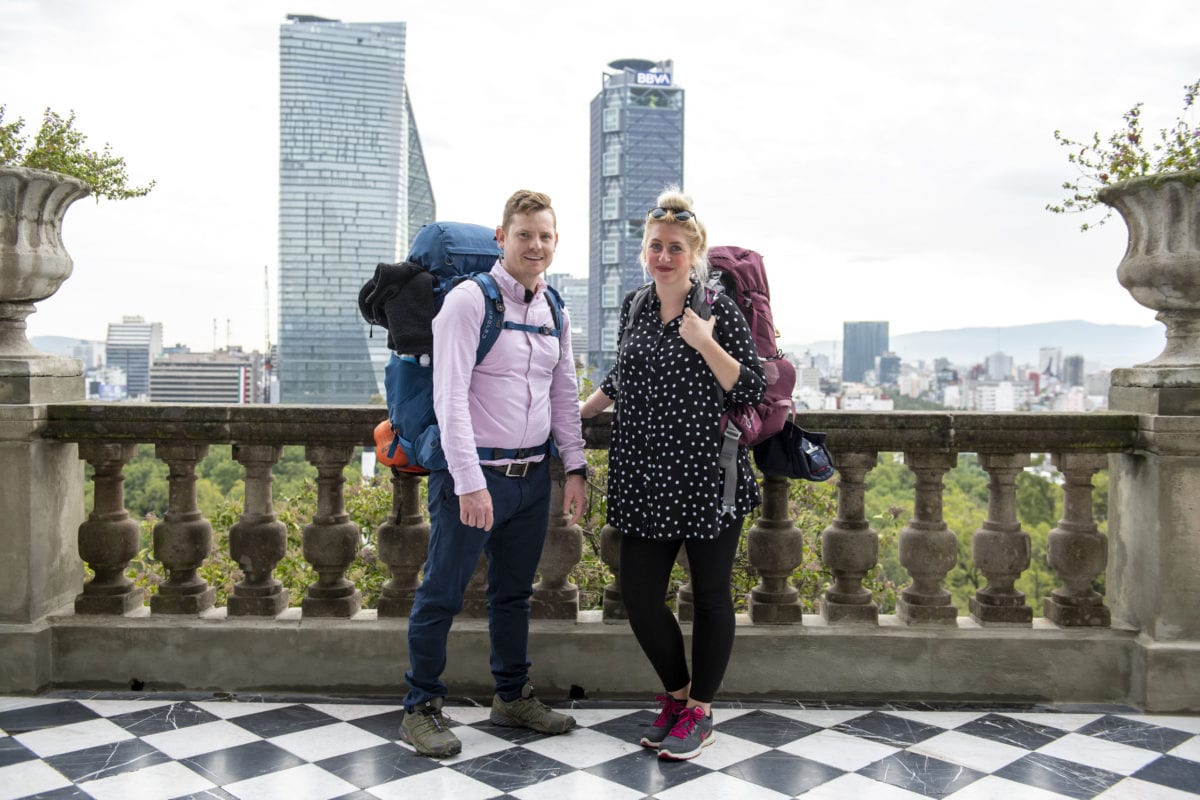The roads traversing Argentina reach before you endlessly with a matching image in the rear-view mirror – in these great expanses you can keep going and going until either the Andes or the Atlantic stop you in your path or you fall off the end of the earth at Tierra del Fuego.
Erin McCloskey
Stretching from the Tropic of Capricorn to the South Pole, Argentina offers big experiences in every sense. The scenery ranges from the epic Iguazú Falls on the lush Brazilian border to the world’s third-largest ice field in the south, home to the ever-advancing Perito Moreno Glacier.
The wildlife includes vibrant communities of penguins, orcas and sea lions on Península Valdés as well as capybaras and caimans amid the unique floating islands of the Iberá wetlands. With Argentina’s lively and welcoming people around and ready to impress you with their diverse culture, a party is never far away.
Leaving behind a past of political and economic instability, Argentina has developed an exceptional tourist infrastructure. Every region has something special to entice the visitor – indeed, one cannot visit Buenos Aires or Patagonia alone and claim to have ‘seen’ Argentina.
So whether you throw on your cowboy boots, hiking boots or tango shoes, you’ll find a place where you fit right in.
For more information, check out our guide to Argentina
Food and drink in Argentina
Subtle differences and regional specialities are found in Argentine cuisine. Patagonian lamb, trout in the Lakes District or river fish in the northeast cannot be beaten in other parts of the country. Here is a general breakdown of what to eat when:
Breakfast
Between dawn and late morning your day would probably commence at a neighbourhood café. With time, this café would recognise your loyalty and know your particular taste in coffee, which can be drunk con leche (with milk) or without, and accompanied by a couple of medialunas or fattorias (the local terms for croissants, often filled with jam or chocolate or other sweet options). Other variations on the coffee theme are cafecito (short and strong), café cortado (short with milk), café lagrima (hot milk with a teardrop of espresso), café doble (double shot) or cappuccino (espresso with steamed milk).
There is also a lovely form of hot chocolate called a submarino, which is hot milk with a bar of chocolate to melt in it. Though tourists are excused with varying degrees of exasperation, it would not be generally considered acceptable to have milk in your coffee following any other meal than breakfast, especially a meal that includes meat, which is usually the case.
Maté, a strong bitter tea, can be drunk at any time but can be prepared in different ways according to the time of day. For example, it can be had with hot milk or even with coffee in the morning, or with sugar or fruit to make it sweeter or more flavourful. In its pure form, however, it can be drunk all day long and much as a coffee mug is carried about by many North Americans. Hot-water dispensers are often conveniently and considerately set up in public areas either as a free service or with a minimal fee to allow people to refill their thermos or top up their maté. Obviously the whole business of sucking warm feel-good juice from a breast-shaped vessel is highly suspect, and Argentines generally see drinking maté as a perfectly normal alternative to doing some work.
Lunchtime
One o’clock is the start of the lunch hour, a loose term since it can last up to two or three hours, siesta time included. Do not expect stores or services to be available to you between one and four o’clock unless you are in the tourist centre of a larger city. Lunch is often the largest meal of the day and most restaurants offer asado and a salad buffet. The most famous and undoubtedly traditional Argentine cuisine is grilled meat. Argentine meat is world-acclaimed.
The animals are free-range and breed naturally (the breeds include the Holando Argentina, Aberdeen Angus, Charolais, Shorthorns and Herefords). The expansive pastures of the pampas offer grazing that is rich and natural resulting in meat that is flavourful and clean (no herbicides, pesticides, growth hormones, etc). The same can be said for Patagonian lamb, which is also free-range.
In ordering your meat dishes, getting some basic terminology straight is your first priority. Laid out on a parrilla or grill, a parrillada is a spread of meats that will include almost every imaginable part of the cow as well as a few chunks of pig, mutton or chicken thrown in for good measure. Asado is the style of cooking and/or often the kind of cut (eg: asado de tira). The asador is the man (it is very unusual and against tradition for a woman to work the parrilla) who grills the meat and prides himself on his skill at keeping the coals at the perfect red-hot degree without the flame ever licking at the meat (tubes are set to carry the fat away so it doesn’t fall into the fire and flare up). Lamb is typically grilled whole and splayed al asador (on the cross). Asado should be served with spicy chimichurri sauce and salad.
If you are able to indulge in two full Argentine meals as well as breakfast, tea and a happy hour, you will definitely be well fed, will probably need to participate in the tradition of siesta and are hopefully not expecting to partake in any strenuous tourist activity such as climbing Mount Aconcagua!
Apart from asado, Italian influences are the most common, such as pizza and pasta, most commonly ñoci (ie: gnocchi), tallarines (plain noodles), ravioli, cappeletis (ravioli of a different shape, looking more like empanadas), sorrentinos (larger ravioli), and milanesa (veal grilled in breadcrumbs). Stews are also popular, including carbonada, made with oxtail, potatoes, carrots, corn and various meats, or a stomach stew called mondongo. Churrasco is another form of barbecue. Pescados y mariscos are fish and seafood. In northern Argentina, empanadas are standard fare. These baked or fried savoury pastries are most commonly stuffed with beef mixed with egg, olives, herbs and spices, or cheese and onion, creamed corn and ham.
Any dish with the term choclo means ‘stuffed’. Tamales and humitas are wonderful northern specialities; tamales are corn and meat wrapped in a corn leaf and steam cooked, and humitas are very similar but lack the meat. Locro is a popular sopa (soup) dish in the north made from meat, tripe, sausage, corn, potato and bean; puchero is a thick soup made with chickpeas, corn and meat. Cazuela (de ternera, de cerdo or de gallina) is a hotpot of stew made of veal, pork or chicken. Fruit pies may be offered as a dessert but usually a coffee (cortado, without milk) would be the cap on your meal.
Teatime
Sweets are abundant a few hours later, at teatime. In the Chubut Valley, owing to the strong Welsh influence, teatime is taken much more seriously and includes breads and jams, cheese, cakes, pies and cookies. Elsewhere, more typically between five and seven o’clock, a simple cup of tea and an alfajor (biscuit filled with dulce de leche and covered in chocolate or icing sugar) would be in order. Dulce de leche is a sweet gooey caramel-like spread and a staple of any Argentine diet.
There is also dulce de batata, a sweet potato preserve; dulce de zapallo, sweet pumpkin preserve; and dulce de membrillo, quince jelly. Churro is a deep-fried pastry stick that may be filled with dulce de leche or chocolate. Chocolate is another famous Argentine delight mainly produced in the Lakes District. One cannot miss the large chocolate shops lined up on the main street of Bariloche. Many of the chocolates and truffles are made with other Argentine sweets such as dulce de leche. Ambrosia is a wonderful dessert similar to zabaglione made with egg yolks, milk and sugar.
Apertif and dinner
In the early evening before dinner (which offers the same options as lunchtime, but is eaten much later than in many other countries – perhaps as late as 22.00) you might fit in a happy hour, when your drink is accompanied with picadas – finger foods, often cold cuts (fiambres), olives, goat cheese (queso de cabra) and fresh cheese (quesillo) among other delicacies. The most common drinks enjoyed in Argentina are wine, cider and beer; hard spirits are less common.
Argentine wine, grown in the Cuyo region, is becoming more refined and internationally recognised; Merlot and Cabernet go especially well with steak. If you are able to indulge in two full Argentine meals as well as breakfast, tea and a happy hour, you will definitely be well fed, will probably need to participate in the tradition of siesta and are hopefully not expecting to partake in any strenuous tourist activity such as climbing Mount Aconcagua!
Beer is usually served in ‘litre’ bottles (actually 970ml). It’s pretty inexpensive, about 12–20 pesos. The large size isn’t because Argentines like drinking in quantity: it’s intended, like a bottle of wine, to be shared (although no-one will bat an eyelid if you swig a whole bottle yourself). Virtually all Argentine beer is lager-style, fairly strong (rarely specified on the label, but about 5%), and you’ll see the same brand names popping up in bars everywhere, mostly Quilmes and Brahma. Many cities have their own breweries, such as Santa Fe and Salta, though you’d be hard pushed to tell the difference between beers. Artisan beers are available, but they’re few and far between.
Note that if you buy a bottle of beer from a shop or supermarket (about 5–7 pesos for a ‘litre’), there’ll be a deposit (about 2–4 pesos) to pay extra on the bottle. If you take the empty back, with your receipt, the deposit is refunded. Or you can buy another bottle of beer, using the empty to pay for the new one’s deposit.
Health and safety in Argentina
Health
Argentina has modern medical facilities and excellent doctors. No vaccinations are legally required, but make sure you’re up to date with your diphtheria and tetanus injections. Hepatitis A vaccine (e.g. Havrix Monodose, Avaxim) and typhoid vaccine may be recommended for some visits, especially if visiting poorer areas or for long stays, Polio has now been eradicated in Argentina, however in the UK polio is given together with tetanus and diphtheria as the all in one Revaxis.
There is no requirement to have a yellow fever certificate when entering the country whether from a yellow fever endemic country or not. However as yellow fever has returned to the north of the country and also exists around the Iguazú Falls this may be recommended for health reasons. Not everyone can have yellow fever vaccine as it is a live vaccine. Seek advice from your GP or a specialist travel clinic. Vaccinations for rabies are ideally advised for everyone, but are especially important for travellers visiting more remote areas, especially if you are more than 24 hours from medical help and definitely if you will be working with animals.
Travel clinics and health information
A full list of current travel clinic websites worldwide is available on www.istm.org. For other journey preparation information, consult www.travelhealthpro.org.uk (UK) or http://wwwnc.cdc.gov/travel/ (US). Information about various medications may be found on www.netdoctor.co.uk/travel. All advice found online should be used in conjunction with expert advice received prior to or during travel.
Safety
Theft
There is little casual crime in Argentina, but you should take sensible precautions, especially in cities. Avoid looking like a wealthy tourist. If you can avoid bringing any jewellery or similar valuables you can free your mind of the worry of losing it; otherwise, keep it to a minimum and wear it with discretion. If you carry a bag in addition to your pack, don’t put it down and do not keep valuables in it: not only can it be snatched, but it can also be picked, slit or slashed open. The same applies to hip pouches, belt bags and the like. Items dangling on a cord such as compact cameras can be easily snipped and stolen. Having spoken to tourists who visited Argentina some 20 years ago, it is apparent that crime and tourist safety were far more of a problem then.
Larger cities are much more cosmopolitan today, with standards of conduct similar to any other major centre in North America or Europe – there is always a chance of being pickpocketed or basically ‘ripped off’ in Buenos Aires as in New York, and by the same token, there is every likelihood that you will encounter no problems whatsoever and be treated with fairness and courtesy. In smaller towns where there is considerable poverty, a tourist who flaunts valuables may become a target of theft but usually the local people would rather share their meal with you than rob you of your funds to buy your own.
Simply use common sense; don’t be a complete idealist and leave your personal belongings lying about, but do not ruin your trip by being paranoid about security either.
A fellow traveller missed his bus while at a coffee stop and had his baggage arrive at his destination several hours before him; he caught a later bus and arrived in a very poor town where many people had no shoes and found his conspicuously North American backpack sitting unattended in the bus station under no apparent threat of pilfering. In summary, simply use common sense; don’t be a complete idealist and leave your personal belongings lying about, but do not ruin your trip by being paranoid about security either.
It would be wise to make a photocopy of your passport and other important documents, such as insurance forms, air tickets, travellers’ cheques, etc, to carry and store separately from the originals. Keep the numbers of your travellers’ cheques, passport, credit cards and air tickets separate from other valuables (with the emergency telephone numbers for lost credit cards), so that if they are lost you can replace them more easily. In addition, send this list as an email to yourself, taking care to use some sort of code. You could also choose to leave photocopies of important documents such as your plane ticket and passport at home with a friend or family member.
To carry reserve cash and travellers’ cheques (as well as passport and air tickets), discreet money belts, neck pouches or secret inside pockets are smart. If your passport is too bulky to carry comfortably and safely, keep handy some other form of identification, such as a driving licence, or photocopies of the key pages of your passport. Divide your money and travellers’ cheques between at least two different places, in your baggage and on your body, and keep your everyday cash separate from your concealed stash.
When visiting places where you don’t have any accommodation, you will want to find a safe place to leave unwanted baggage. If you are leaving a hotel, they will most likely store it for you free of charge or for a minimal fee until later in the day, or even overnight if you are going on an excursion. Hostels are especially helpful in this way. Therefore, be sure you can lock your bags and make sure that the storage facility is also locked. If it is not locked storage or if other people have unsupervised access, you might also consider having the means to lock your bag to an immoveable object (a bike lock would work).
Female travellers
Argentina is a safe country to travel in for women and it is tolerant of homosexuality. Use common sense and do not take risks that you wouldn’t take at home or in any city environment: don’t walk alone in shady, unlit, deserted streets; be aware of which areas have higher crime rates; don’t accept car lifts or social invitations from strangers; be aware of your body language, etc. This said, don’t be paranoid either. Argentine men are very forward and gregarious. Beautiful women are appreciated and will receive whistles, catcalls and comments; these are generally tasteful though not always.
A woman can respond to polite attention with a smile but is best to ignore the rude and avoid further interaction. Both male and female homosexuality is not only tolerated but, in cities such as Buenos Aires, openly expressed. Gay pride is celebrated and there are ever-increasing numbers of gay-friendly bars and dance clubs, including milongas (tango clubs). Rural areas of Argentina, however, are more staunchly Catholic and conservative; sexuality (of all kinds) is a subject that is viewed and expressed with discretion, and overtly sexual behaviour and dress is offensive.
LGBTQ+ travellers
Argentina is as gay-friendly as Western Europe, arguably more so. In July 2010, it granted same-sex marriages the same legal rights, responsibilities and protections as those of heterosexual married couples. Gay couples and singles will encounter few problems while travelling, most likely none at all. The traditions of machismo may be alive and well, but in a country of passion, art, sultry dance, and male kissing as a matter of course, gay visitors fit in perfectly OK.
With its vibrant and open-minded nightlife scene (including same-sex tango venues), and massive annual Gay Pride, Buenos Aires is effectively the pink capital of South America. Themes of gender identity and sexuality are something of a trendy topic at the moment in the city’s 200 theatres. Gay single visitors certainly do not have to feel lonely, though the same precautions on casual pickups apply as anywhere else. Finding good accommodation that welcomes same-sex couples is not a challenge; indeed, the concept of the gay couple running an immaculate boutique hotel or bed and breakfast is something of a Buenos Aires archetype.
Outside Buenos Aires things are lower-key. As with most countries, rural areas can be more conservative, though hostility is rare. The wine region of Mendoza is probably the most popular destination with gay travellers outside the capital. Not only does it enjoy gay-friendly bars, restaurants, saunas and shows, it even features a Gay Vendimia Festival as part of the annual wine celebrations every February/March – complete with the crowning of a (drag) Wine Queen. Other large and cosmopolitan towns, such as Córdoba and Mar Del Plata, have smaller but welcoming gay scenes; check the local listings magazines for the latest trendy venues. Several travel agencies specialise in gay-friendly trips to the country. Patagonia, while not specifically marketed as such, is a destination much enjoyed by gay travellers.
Travelling with a disability
Although disabled travellers are not yet able to tango with ease from Tierra del Fuego to Iguazú, Argentina can boast a developing accessible-tourism industry. There has been disabled rights legislation here since 1982, and in 2002 the first acts were passed to make tourist facilities accessible by law. This certainly doesn’t mean that every hotel has rooms with roll-in showers, but main tourist centres and public buildings often have access by means of ramps or lifts. This is a sure sign that travel for all is becoming a priority.
Travel and visas in Argentina
Visas
A valid passport is necessary for all tourists entering Argentina. A tourist visa is not required by EU, US, Canadian, Australian, South African or New Zealand citizens.
On arrival, their passports will be given a stamp valid for a 90-day stay. Going over a border and re-entering – even for a day trip to Uruguay, say – will result in a new 90-day stamp with no fuss. Upon arrival in Argentina you will be given a tourist card which must be handed in when leaving the country; if you have lost it, you will be fined. However, note that American, Australian and Canadian citizens arriving in Argentina by air (at Ezeiza or Jorge Newbery) have to pay a one-off fee (on arrival, payable by cash or card) of US$140, US$100 and US$75 respectively.
The US payment is valid for multiple entries for ten years; the Australian, multiple entries for a year; and the Canadian, for a single entry, although a multi-entry version for five years is available for US$150. These nationalities don’t have to pay an entry fee if they arrive any other way.
Getting there and away
An unprecedented surge in tourism was brought about by the devaluation of the Argentine peso in 2001, climbing by about 40% the subsequent year and continuing to rise since then. Though the country’s improved economic situation no longer makes it feel cheap for visitors, tourism has become one of the most important economic activities in the country. Argentina is relatively easy to get around but expect certain inconveniences at times, such as late buses or lax business hours (this varies region to region and with the size of the city or town).
In poorer areas you may not find convenient transport connections or strict adherence to opening hours. That said, Argentina has a higher standard of service than other South American countries. This is largely due to the strong history of tourism and cosmopolitan attitudes in Buenos Aires and the enormous increase in ecotourism in Patagonia. I use the term ecotourism loosely, since it seems to be used for a normal style of tourism offering wildlife-watching and wilderness settings; it rarely, however, implies any environmental impact awareness such as innovative waste disposal, energy conservation or minimal water use. You will have to take it upon yourself to be as low impact as you can and make polite suggestions to hotels and restaurants as to what you would like to see in the future.
In relation to transportation, oil and gas are big business in Patagonia and fuel prices are low compared with North America and Europe, and the only way to move freely to remote areas is with a car. Buses provide frequent service to almost any decent-sized town, but if you want to move beyond the towns you will need your own wheels. Argentina is a big country and to cover larger distances you may need to take bus rides of over 24 hours (sample distances: Buenos Aires to Ushuaia, 3,200km; Salta to Ushuaia, 4,700km). Thus you may want to consider using both flights and buses for an efficient use of your time.
By air
Book international flights at least a month in advance for the best fares. If you intend to take two or more domestic flights in Argentina during your trip, you would be wise to purchase a Visit Argentina airpass from Aerolíneas Argentinas (www.aerolineas.com.ar), typically sold as two internal flight coupons per international flight. Domestic flights are reasonably priced but the airpass effectively lets you take any internal flight for US$100–150, a discount of up to 50% (with lower discounts if it is not bought in conjunction with an international ticket).
Airpasses must be booked in advance and purchased in the traveller’s country of residence (not in Argentina). All coupons must be fully paid for together with the international ticket; the first flight must be booked then, while the remaining coupons may be booked at any time with rebooking permitted (usually at a cost of about US$20), but not rerouting. The entire journey must be completed within the validity of the international ticket. Stopovers are not permitted. Discounts are available only for children under the age of two years.
Getting around
By air
Most cities have airports with daily connections to Buenos Aires, although not necessarily any direct flights to geographically closer cities; often you will have to go via the hub of Buenos Aires and backtrack. There are frequent flights between Buenos Aires and major cities such as Córdoba, Bariloche and Mendoza.
Córdoba is becoming more of a hub with direct flights to popular destinations such as Salta and Iguazú; flights from Ushuaia in particular may call at cities such as El Calafate or Trelew, owing to its isolation and tourist demand.
As mentioned above, it may be better to buy an airpass for internal travel; both Aerolíneas Argentinas and LAN Argentina try to restrict foreigners to their more expensive (and flexible) fares, but if you book online claiming to be resident in Argentina and request airport pickup of tickets (or e-tickets), or use an Argentine-based travel agency, it’s possible to get around this.
By bus
Buses are the most popular and economical mode of long-distance travel in Argentina and the quality of the major operators and their vehicles are comparable to those in North America (particularly Mexico), and better than many in Europe. The trip from Buenos Aires to Bariloche, for example, costs 460 pesos, about two-thirds of the airfare, but takes 22 hours.
Regular buses have reclining seats, small toilets, screens showing subtitled action films or romantic comedies, and machines dispensing a coffee-coloured liquid and water. For not much more money you can have a lot more comfort with a level of service referred to as semicama, cama, or cama ejecutivo. The higher the price, the larger your seat and the further it reclines. These seats fold down almost into a bed allowing a comfortable night’s sleep, and also saving on accommodation costs.
Bus terminals are bewildering places. There will almost certainly be no noticeboard with arrivals or departures, and definitely no information board with timetables. Several different, rival firms will operate buses to your chosen destinations, all with their own ticket offices. But there’ll be a general information desk somewhere; so find that and ask about your destination. They’ll tell you times and companies, and which ticket office to try. In practice, many companies operate alliances on various routes, so you may well find company A selling you a ticket for company B’s bus. You can get a list of services and prices to your destination from the websites www.omnilineas.com (from Buenos Aires) and www.plataforma10.com (for all routes). But they’re by no means comprehensive, with many services (especially local ones) not shown. The only sure way to find out when, or if, there are buses between places X and Y is to phone a likely company; or better still, turn up at the station and ask at the information desk.
Buses are late surprisingly rarely; nine out of ten trips they’re pretty much on time. If you have a wait, bus stations are usually good places in which to do so, with bars, basic restaurants and internet access. Even in the early hours of the morning, there will be people around, some friendly and well-fed stray dogs, and probably even an open snack bar. Most bus terminals are walkable from their town centres.
In January and February, the main holiday period, buses may be booked up weeks in advance. Conversely, at low-season times there is a lot of competition, so you should always ask for a student discount or a promoción, which close to departure time may be as much as a third off. Buses may not run on backroads or to national parks in winter.
Your baggage should be loaded for you and when you reclaim it, a tip of a peso or two is expected. You will usually be given a baggage tag in order to reclaim your belongings.
By train
A cheap and civilised (if very slow) way to travel, though rarely possible beyond the commuter lines and tourist trips, is by train. Argentina has an extensive railway system, but unfortunately it is largely defunct. In 1993, the federal government withdrew funding for the railways, leaving it to provinces to decide on subsidies. As a result there is limited passenger service in Buenos Aires province (with certain routes that are actually recommended for visiting the small towns outside Buenos Aires city, such as Tigre), and far more limited service elsewhere.
The extreme sparsity of settlements in the vast pampas of the south meant that railways were never an economic proposition there, except for a few special lines such as that from the Río Turbío coal mines to the sea, and the Viejo Expreso Patagónico to Esquel, La Trochita, made famous through Paul Theroux’s The Old Patagonian Express. Nostalgia for the old trains is what has saved the last few lines now catering mostly to sightseers: La Trochita, as well as the Tren a las Nubes (Train to the Clouds) in Salta, Tren de las Sierras in the Central Sierras, and Tren del Fin del Mundo in Tierra del Fuego. Indeed a journey by these trains is a beautiful way to see the passing scenery.
By car
Although much more expensive than taking buses, the freedom of movement a car gives is often necessary to get where you want to go efficiently, especially in Patagonia. That said, the distances are great and many roads are in poor condition, with service stations few and far between. The roads in Argentina are reputedly dangerous, and signs marking one-way streets are often discreet with just a small arrow on a wall. In the extreme reaches of the country, that is in the far northwest, the depths of the central pampas or in remote areas of Patagonia, a car may not be a wise idea at all.
The best option may be to use the bus for longer journeys and rent a car for a day or two to make short excursions in areas that buses reach rarely or not at all. For example, take the bus to the Lakes District from Mendoza or Córdoba (or Buenos Aires, although there are frequent and affordable flights for this journey) and then hire a car to tour around the scenic areas and small towns throughout the area. You may prefer to hire a pick-up (camioneta) if you are intending to spend a lot of time on unsurfaced (ripio) backroads. There are car-rental companies in every major city or town, often with offices at the airports and bus stations, and international companies such as Avis and Hertz are both commonly found.
In order to drive in Argentina you will need an International Driving Permit, available at a low cost from your home automobile association. If you plan to take the car into a bordering country, be prepared for a lot of additional expense and bureaucracy. Specific insurance for taking a car across international borders is required.
When to visit Argentina
The opportunities for entertainment and adventure are boundless in Argentina and there is something for everyone to enjoy. It is also a large country and unless you have copious amounts of time to see it all, you will have to make some choices that will partly be based upon season. Areas that are far apart geographically may in fact have contemporary seasons, while the places in between are definitely out of season. For example, winter is the time for snow-sports in the Patagonian Andes but not so great for visiting the coast to see wildlife or enjoy the water, while in the far north of the country, it is a good time to visit to avoid the sweltering summer temperatures. To save time you may choose to fly across the country and thus find yourself in a subtropical jungle one day and atop a glacier the next. The downside is that you will miss the landscapes and little towns in between.
The opportunities for entertainment and adventure are boundless in Argentina and there is something for everyone to enjoy.
Argentina’s distinctly different regions offer diverse experiences at different times of the year. The northern beaches fill with foreign tourists as well as Argentines on summer vacation in December and January. This is the best time of year for the beach but not for avoiding crowds and inflated prices. Patagonia is best for coastal wildlife-watching from September to November: the right whales are in their calving grounds until November, the elephant seals give birth in early September, and the penguins start nesting in September, with hatching beginning in late October. The other time to visit Patagonia is the ski season, in the southern hemisphere winter, from mid-June to October, with July being the peak season (with busier slopes and more expensive ski passes).
The northeast, with its waterfalls, wetlands, jungles, subtropical wildlife, Jesuit missions and archaeological ruins, should be avoided in the rainy season, with frequent flooding around September followed by scorching temperatures in the subsequent months; however, October is one of the best times to see butterflies at Iguazú Falls. The northwest is known for stunning desert landscapes in the mineral-rich colourful mountains, cardón cactus and ancient cultural sites, high plateaux with vicuñas, a vibrantly alive culture of music and dance, crafts and cuisine; midsummer (January–February) is extremely hot but spring and autumn are great. The beautiful Central Sierras offer more stunning mountain landscapes to enjoy. The missions are scattered throughout this region, which is also popular for adventure sports such as rock climbing and paragliding. The best time of year to visit is early or late summer (midsummer is quite hot).
Climate
Argentina’s climate is classified as temperate; indeed it’s the largest temperate country in South America. However, climate obviously varies with geography, from north to south in the case of temperature and from east to west in the case of humidity; the seasons, however, differ only in their variations of temperature, precipitation and duration. Argentina is in the southern hemisphere, thus the seasons occur during the opposite months from Europe and North America. Spring arrives around November; January and February mark the peak summer months and March is the end of summer when children return to school.
The autumn months are April and May and winter can be perceived as early as June in the southern regions near the mountains where snow often settles and temperatures frequently drop below freezing. However, in the north winter rarely means snow – if it occurs it will not stay on the ground – but it does mean rain. The wet season here is from November to March (the wettest month in Mesopotamia is September), and the driest time of year is from May to October. The northwest is generally hot but high-altitude deserts cool off substantially in the evenings and combined with wind the perceived temperature can be close to freezing.
Moving south, average temperatures fall and summers become somewhat shorter. In the far north average temperatures are in the 30s in summer and the high teens in winter, with freezing temperatures in the desert overnight. The central region is relatively warm all year, with hot summers (25–35°C) and winter temperatures always above zero. Summers are cooler and windier in Patagonia and the winters are mild, except in the far south and in the high mountains where temperatures drop below freezing. In Tierra del Fuego summer temperatures are mild, rarely reaching 20˚C, with long hours of daylight.
What to see and do in Argentina
Buenos Aires
Part New York, part Paris, but all Buenos Aires, this vast city never gives a dull first impression. Beautiful European architecture stands among the bland North American-style high-rise buildings, garish neon lights and advertising billboards. Cobbled old artisan streets lead to 21st-century docklands development, and then to a riverside wilderness. The energy of big-city traffic and gridlock, the pulsing nightlife where dinner can start at midnight, and the large and long-established metro system imply prosperity – though there’s bleak backstreet poverty too.
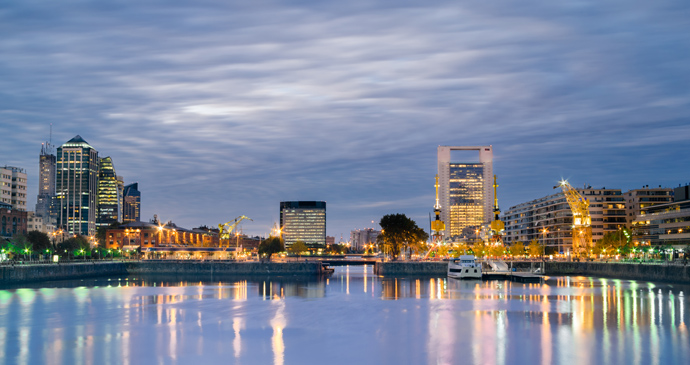 Bright lights in the big city – Buenos Aires never fails to stun with its beautiful architecture and unique rhythm © alex_black, Shutterstock
Bright lights in the big city – Buenos Aires never fails to stun with its beautiful architecture and unique rhythm © alex_black, Shutterstock
The city effortlessly blends South American colour, rhythm and spice with European elegance, style and sophistication and North American economic and commercial ambitions, all the while maintaining a culture, a language, folklore, music and dance that is purely Argentine, and distinctly porteño. And yes, tango really is everywhere, from the gaudy street-dancer kitsch of Caminito to the urgent city-music fusion pouring out of shops and restaurants.
The city is referred to as the Capital Federal, or sometimes the Ciudad Autónoma de Buenos Aires or Autonomous City of BA, or shortened to ‘BsAs’. It has a population of over three million; the metropolitan area of Gran Buenos Aires, also known as the Gran Aldea (great village), includes the Capital Federal and surrounding districts, or partidos, and reaches a population of 13 million. Around 1910, Buenos Aires became the first South American city to reach a population of one million; its inhabitants came to be referred to as porteños or port residents, a great mix of Italian, Spanish, British, Jewish, Afro-Argentine, German, and Portuguese immigrants. It is a unique city within Argentina and the people even have a characteristic accent that differs from the rest of the country.
Buenos Aires was actually founded twice, some say even three times. The first was in 1536, by Pedro de Mendoza, leading one of the first Spanish expeditions to Argentina. He arrived at a large estuary that had been previously claimed by Juan Díaz de Solís in 1516 on the first, and unfortunately fatal, expedition to Argentina, sailing down from Brazil in search of a southern passage to the Pacific. This second voyage followed the fall of the Inca Empire in 1532; the King of Spain, Carlos I, sent Mendoza’s group to counter Portuguese advances in the territory. The group was able to settle on the southwestern bank of the estuary, and the settlement was soon named Nuestra Señora Santa María del Buen Aire.
However, the native Americans who were long established in the area did not perceive their lands as available for settlement. Their warriors, who had already become skilled horsemen, launched repeated attacks upon the settlement and any exploration parties it attempted to send out. Shortage of food and supplies led Mendoza to abandon the settlement in 1537. It was not until 1580 that Buenos Aires was founded for the second time at the ‘River of Silver’ (Río de la Plata, or River Plate) by Juan de Garay. His intention was to establish the Río de la Plata as a gateway for trade.
It was during these early days of pioneering the pampas that the leather and beef industry was born, and so was born the famous gaucho or Argentine cowboy.
Rudimentary plans for a town took shape with streets laid out in a grid. In the centre was established the Plaza Mayor, today the Plaza de Mayo, and a fort was erected on the site where the Executive Office Building now stands. Buenos Aires was subordinate to Asunción, which was in turn subordinate to the Viceroyalty of Lima, which was subordinate then to Madrid, the Spanish capital; it would take a couple of centuries for Buenos Aires to grow and match Lima’s level of power and status. Meanwhile, it was cut off from communication with Spain owing to colonial and mercantile bureaucracy. The large trading fleets from Spain would stop in Cuba and at Portobello on the Isthmus of Panamá, send their goods by mule across the isthmus to the Pacific and load them onto fresh ships for Callao, near Lima. This route was relatively safe from attack but very lengthy and costly and Buenos Aires was quite neglected.
Buenos Aires was only permitted to receive registered ships, sailing only every year or so, and up to five years could pass without a registered ship arriving from Spain. The porteños in those days suffered greatly under this system; culturally they could not adapt to the Querandí’s hunting-and-gathering lifestyle, and it was inevitable that bootlegging would become a means of survival. Against Spanish authorisation, the porteños began trading with the British and Portuguese vessels that passed; and what they had to trade was leather. Cattle and horses abandoned by the Mendoza expedition had by this time grown into semi-wild herds that populated the pampas. The leather was too crude to trade with Spain, but it was acceptable for contraband trade. It was during these early days of pioneering the pampas that the leather and beef industry was born, and so was born the famous gaucho or Argentine cowboy.
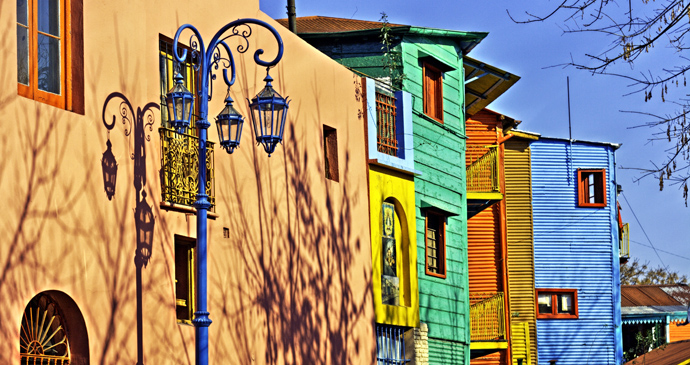 The colourful street museum and alley of Caminito in the La Boca neighbourhood © Luis Argerich, Wikipedia
The colourful street museum and alley of Caminito in the La Boca neighbourhood © Luis Argerich, Wikipedia
The increase in commercial activity, smuggling and the slave trade caused Buenos Aires to expand. By 1776, its population exceeded 25,000; Spain had come to recognise the importance of Buenos Aires and in that year made it the capital of the newly created Viceroyalty of the River Plate, which included the wealthy silver region of Potosí (in present-day Bolivia). In 1778, the Atlantic ports were allowed to trade freely, giving a big boost to the city’s growth. In 1800, the British Empire began implementing its colonial expansion policies and the Río de la Plata was in its sights as a potential British base for trade.
The first attack on Buenos Aires in 1806, led by Commander Beresford, was opposed by Spanish troops led by Santiago de Liniers from Montevideo (taking command in the absence of Viceroy Rafael de Sobremonte, who had fled at the onset of the attack), together with an urban militia of Spanish civilians, Creole patricios and peasant gauchos. The battle was short and the British force surrendered and was interned in Luján. A second ill-advised attack in July 1807 by 10,000 men under Major-General John Whitelock was repelled by the heroic defence of the urban militia, aided by women and children using such tactics as pouring boiling oil and water from windows and rooftops and firing cannons from balconies (in particular the balcony of Defensa 372, now the Museo Nacional del Grabado).
Whitelock’s headstrong frontal attack on the fortified city resulted in the immediate loss of almost a third of his men. He accepted a truce offered by Liniers and was evacuated to Montevideo, from where he returned to Britain to face court martial. These battles are known as La Reconquista and La Defensa and were remarkable because the residents themselves, the porteños, organised their own defence without the aid of the colonial power and with decisions being made without reference to Madrid or intervention from the viceroy.
Meanwhile in Europe, Napoleon had crossed Spain to invade Portugal (allied with Britain) with the assistance of Charles IV; Charles was forced to abdicate and was replaced on the throne by Ferdinand. Napoleon forcibly re-established Charles as king, in order for Charles to then yield it to Napoleon, who then put his brother Joseph on the Spanish throne. This created anti-French sentiment in Buenos Aires leading to the execution of Liniers solely on the basis of his French name. On 25 May 1810, the citizens of Buenos Aires revolted and disposed of Viceroy Sobremonte for he was seen as a coward and not capable of protecting the River Plate.
The May Revolution of 1810 replaced him with an autonomous governing body. Buenos Aires itself had reached a population of over 300,000, and recognisable neighbourhoods, barrios, had been established. Some consider the city to have had a third founding with mass immigration in the late 19th century. A century later, Buenos Aires’s population had grown eightfold and the city was modern and cosmopolitan. The first subway line (the first in Latin America) opened in 1911, and the city’s first skyscraper, the Barolo Building, appeared in 1920. By 1950, Buenos Aires was one of the largest cities in the world.
Esteros del Iberá Wetlands
The remarkable Esteros del Iberá (‘swamps of Iberá’) is one of South America’s greatest must-sees. On vast, slow-moving lakes float huge islands of vegetation, home to capybara, marsh deer, caiman, an astounding number of birds, and many more animals such as armadillos. All are easily encountered close-up at leisure from boats and kayaks, on foot or on horseback.
Yet the area, being remote and time-consuming to get to, is relatively little visited – certainly when compared with the other great natural watery wonder of the region, the falls of Iguazú (whose name like ‘Iberá’, takes its initial ‘i’ from the Guaraní word for ‘water’). There’s only one settlement in the Iberá Wetlands: the small village of Carlos Pellegrini, three hours by dirt road from Mercedes, a fine base for a few days of quiet outdoors wildlife-spotting.
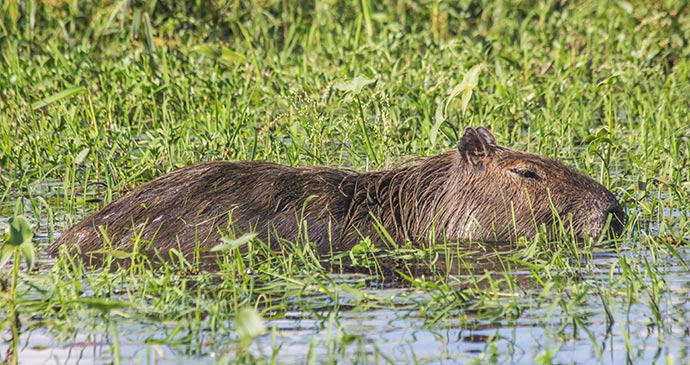 Get up close with capybara at Esteros del Iberá © Marc Venema, Shutterstock
Get up close with capybara at Esteros del Iberá © Marc Venema, Shutterstock
There’s only one settlement in the Iberá Wetlands: the small village of Carlos Pellegrini, three hours by dirt road from Mercedes, a fine base for a few days of quiet outdoors wildlife spotting.
Iguazú Falls
Alvar Nuñez Cabeza de Vaca, the second governor of Río de la Plata, presumed that he was the first to discover the falls on his voyage from Santa Catarina to Asunción in 1541, and named them the Santa María Falls. The Guaraní indigenous people, however, were here much earlier and had already named them Iguazú (‘Great Water’). (The ‘i’ is the Guaraní for ‘water’, and the same ‘i’ as in ‘Iberá’, though the Guaraní pronounce it more like a swallowed ‘urr’.) The Garganta del Diablo (Devil’s Throat) swallows 1,700m³ of water per second with an unquenchable thirst, and still more water from the enormous floodplain spills over hundreds of smaller cascades.
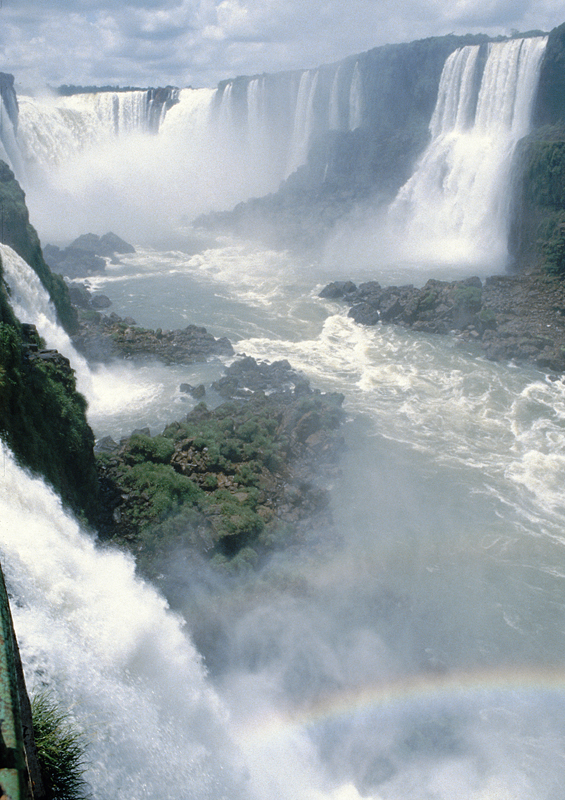 (Photo: Immerse yourself in this incredible natural wonder and take a walk along the boardwalks over the rivers to the falls © Reinhard Jahn, Wikipedia)
(Photo: Immerse yourself in this incredible natural wonder and take a walk along the boardwalks over the rivers to the falls © Reinhard Jahn, Wikipedia)
The 67,620ha surrounding the Iguazú Falls were given National Park status in 1934 and designated a UNESCO World Heritage Site in 1984. The natural wonder of the falls and the high biodiversity of the subtropical rainforest (2m of precipitation on average per year) make it one of the most valuable and beautiful parks in the country; yet that recognition came almost too late. The subtropical Paranáense rainforest that once covered a great area of Brazil, Paraguay and Argentina has been reduced to 6% of its original area.
The forest around the falls is successional, or in the early stages of re-growth, having been cleared many years ago. Orange trees can be found close to the falls, where early foresters dropped pips from the fruit they brought for their lunch – oranges are not native to the Americas. Old-growth jungle is characterised by a full canopy of tall trees blocking the sun and thus leaving the understorey quite bare.
Of the 1,000-plus bird species in Argentina (South America has one of the highest diversities of birdlife on the planet), around 450 have been recorded in Iguazú, making it Argentina’s richest hotspot of biodiversity. The great dusky swift, the park’s emblematic species, can be seen flying over the falls and in the mists, roosting and nesting on the cliff faces beside and even behind the falls. Toucans are elusive, but can be seen at dawn and dusk. Bright green birds such as blue-winged parrotlets and green-headed tanagers are often overlooked hiding in the jungle foliage, but are stunning to see.
One of the more interesting behaviourally is the red-rumped cacique. More often heard before seen, their rowdy chatter will draw attention upwards to large colonies of hanging nests in a single tree. Iguazú in springtime is a wonderful spectacle with over 200 species of butterfly, enchanting clouds of mariposas converging en masse and filling the jungle with moving colour. Eighty mammal species, including caí monkeys (Cebus paella nigritus) and the elusive jaguar, are known to inhabit the jungle. Coatis (members of the racoon family) are an obvious presence, easily habituated to human presence by scrounging for food scraps.
Perhaps the most ominous forest creature is the mythical river snake or Boi. The Guaraní tell the legend of the giant snake that dwelt in the Río Iguazú, appeased by their ancestors with the sacrifice of a village maiden. One chief, Tarobá, loved the next intended victim, Naipi, so ran away with her into the forest to save her. Boi was so furious that it broke the riverbed with an angry twist of its back, causing the lovers to fall into its lair and thus creating the falls. Boi turned Tarobá into the trees that canopy the upper falls and Naipi’s hair became the waterfalls. Boi lives in Devil’s Throat, preventing the lovers from meeting; but when the sun shines at a sympathetic angle it creates a rainbow to link the couple, if only for a few minutes.
Los Glaciares National Park
This park is made famous by the 35km-long, 5km-wide and 60m-high Perito Moreno Glacier, probably the first thing that comes to mind when thinking of the national parks of Argentina. Even larger is the Upsala Glacier, 60km long and 50m high. In the park’s northern sector, Mount FitzRoy challenges mountain climbers from around the world to reach its 3,375m summit. A few thousand years ago the entire area of the park was covered by glaciers, and the still-enormous icefields that remain (2,600km² of icefields from which 47 major glaciers descend) and the huge glaciated valleys and moraines suggest the intensity of such an ice age.
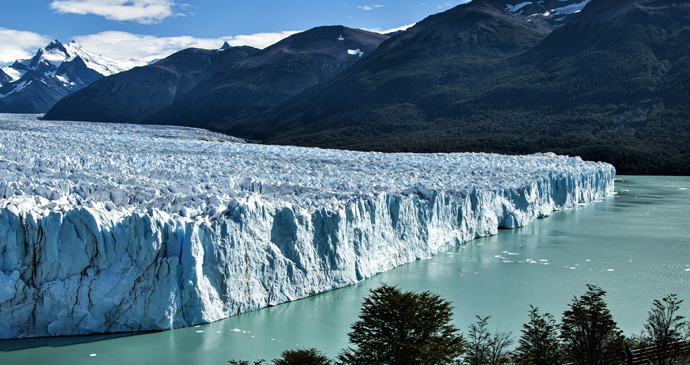 The Perito Moreno is Los Glaciares’ most famous glacier © takawildcats, Shutterstock
The Perito Moreno is Los Glaciares’ most famous glacier © takawildcats, Shutterstock
When the climate warmed, the glaciers began melting and retreating to their current strongholds on the mountains. This retreat continues as the climate warms, indeed at an accelerating pace. The area receives about 8m of precipitation per year, more than the Amazon rainforest, but in the form of snow. The Perito Moreno Glacier moves at a rate of 1.5–2m per day; however, the front of the glacier calves off at an equal rate so that the glacier remains more or less at the same location.
The famous breaking of the Perito Moreno Glacier occurs when the ice crosses the Canal de los Témpanos that connects the Brazo Rico to Lago Argentino and meets the opposite shore. Thus the Brazo Rico is cut off and its water level rises as it continues to receive rainwater and melting ice and snow from the mountains and glaciers. Eventually the pressure of water begins to push past the point of contact of the glacier with the land, creating a small tunnel. This tunnel increases in size until the ice above it becomes an ice bridge that eventually wears thin and breaks in a spectacular event of tons of crashing ice. The first known breaking occurred in 1917 – the only evidence being the sudden flooding of a 700-year-old forest.
Surprisingly, in the 1950s, when swelling of the lake was causing the flooding of the estancias, the local people tried to break the ice bridge by force. First they tried using salt, then carbon. Then they called in the air force to bomb it! They were all futile efforts; it will only break when it is ready, by the true force of nature.
In 1940, the first breaking actually recognised by geologists at the time of its event brought it to the attention of tourists. Since then the phenomenon has taken place every two to four years (with gaps from 1956 to 1970 and 1991 to 2004); scientists cannot predict with accuracy when the next break will occur. Surprisingly, in the 1950s, when this swelling of the lake was causing the flooding of the estancias, the local people tried to break the ice bridge by force. First they tried using salt, then carbon. Then they called in the air force to bomb it! They were all futile efforts; it will only break when it is ready, by the true force of nature.
The park was founded in 1937, and its 717,800km² area was designated a UNESCO World Heritage Site in 1981. Thirty percent of this great park is covered in glaciers – 365 individual glaciers in total. The 13 largest of those on the Atlantic watershed are the Perito Moreno, Marconi, Viedma, Moyano, Upsala, Agassiz, Bolado, Onelli, Peineta, Spegazzini, Mayo, Ameghino and Frías glaciers.
Península Valdés
On the coast of Chubut is the incredible wildlife haven of Península Valdés and nearby points. The peninsula itself was designated a UNESCO World Heritage Site in 1999 for its wildlife, most importantly the southern right whale (Eubalaena australis), which comes to breed in Golfo Nuevo and Golfo San José between June and mid-December. The whale itself was declared a Natural Monument by the Argentine government in 1984.
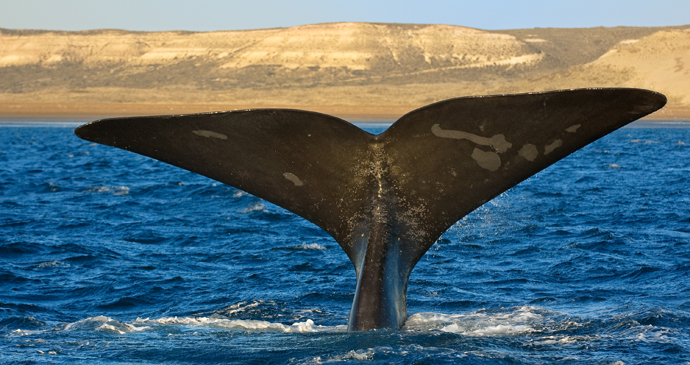 The Península Valdés is an excellent place to go whale-watching © elnavegane, Shutterstock
The Península Valdés is an excellent place to go whale-watching © elnavegane, Shutterstock
The coastline near Caleta Valdés from Punta Norte to Punta Hércules has also been named a Natural Monument – sea lions and some 40,000 elephant seals (with approximately 10,000 pups born each year between August and November) breed along this 200km stretch of coast.
Quebrada de Humahuaca
Added to UNESCO’s World Heritage List in 2003, the Quebrada de Humahuaca is a corridor of small villages, with many traces of prehistoric hunter-gatherer communities, pre-Incan and Incan archaeology, set amid mountains up to 6,000m in altitude. Its lively ethnic market villages and small towns offer vibrant-hued clothes and handicrafts, as well as traditional local dishes such as llama. Thanks to mineral deposits, even the mountainsides here are often striped in paint-box colours.
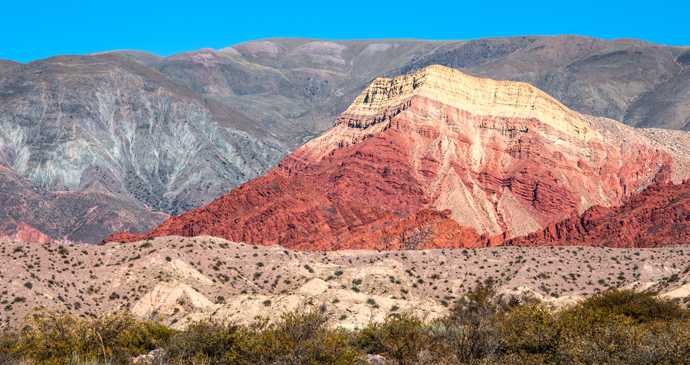 The brightly-coloured Quebrada de Humahuaca stretches all the way to Bolivia © Ksenia Ragozina, Shutterstock
The brightly-coloured Quebrada de Humahuaca stretches all the way to Bolivia © Ksenia Ragozina, Shutterstock
The Circuito de la Quebrada is well serviced (and very cheaply) by local buses (so beware: no toilets!) and some coaches. If you’re day-tripping by bus from Jujuy (or Salta), visit Purmamarca first; carry on to Tilcara; finish with Humahuaca; then return. However, there are many other settlements worth visiting, and there are good accommodation options in all the villages mentioned above. You can happily spend two or more days exploring the valley. Having a car will give you the most freedom to move at your own pace and stop at all the villages.
In practice you can simply turn up at Jujuy’s main bus station without worrying too much about schedule details: departures are plenty. Several local bus companies run services up the valley through the day from Jujuy to Purmamarca (P), Tilcara (T), Humahuaca (H) and La Quiaca (Q): Evelia (hourly to H, T; some stop at P); El Quiaqueño (every two–three hours to H, Q); Arco (lunch and midnight to T, H, Q); Balut (four per day to Q); JamaBus (morning and late night to T, H, Q); Panamericano (hourly to T, Q, P at 11.00 and 17.00). From Purmamarca to Tilcara, JamaBus and Evelia provide over a dozen services per day.
San Ignacio Miní
This pleasant small town is an hour by bus from Posadas (63km east on Ruta 12), and home of one of the most important ruined missions. San Ignacio is a large archaeological site where between 1609 and 1818, the Jesuits established one of the most significant and unique social, cultural and religious centres of South American history. Three other missions are in the area: Santa Ana, Nuestra Señora de Loreto and Santa María La Mayor. San Ignacio is also a good base to explore the surrounding countryside, villages and riverscape, and that rarity for most of northern Argentina: hills.
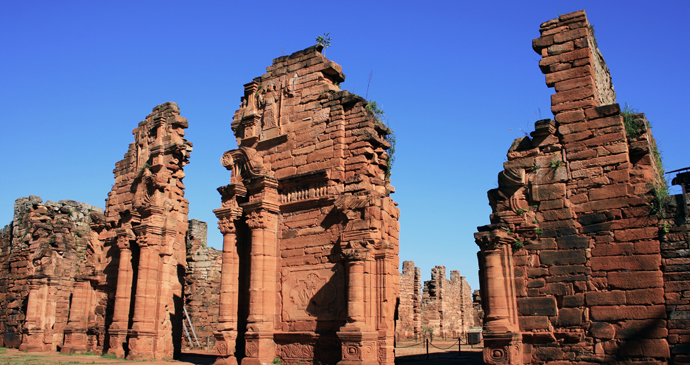 The Jesuit ruins in San Ignacio Miní © diegorayaces, Shutterstock
The Jesuit ruins in San Ignacio Miní © diegorayaces, Shutterstock
Visiting the missions
The Interpretive Centre Ruinas de San Ignacio, near the entrance to the ruins (tel: 470186; open: 07.00–19.00 daily), has displays and installations interpreting the culture and mission lifestyle. There is a very good state-of-the-art 3D sound and light show amid the ruins, a very atmospheric experience on a summer evening. It starts at 19.30 every day, lasts an hour and costs 30 pesos. A ticket covering all four missions costs 30 pesos and lasts for 15 days. San Ignacio’s is very impressive and you can spend a few hours wandering round; there are good multi-lingual information lecterns scattered around. Cheap local buses (30–45 minutes, 3–4 pesos) run hourly to Santa Ana and Loreto, or a taxi will charge around 100 pesos to take you to both, including waiting time. The tourist information office on Sarmiento and Rivadavia can give you detailed schedules. Santa María, a couple of hours away, requires a full-day excursion. If you’re keen on exploring all the missions, it’s most convenient if you have your own car.
The Jesuits were expelled from the area in 1767, and the missions themselves raided and destroyed by Portuguese and Paraguayan invasions between 1816 and 1819. A remarkable civilisation that had prospered for a couple of hundred years was thus destroyed in three.
San Ignacio Miní was founded in 1610, and moved to the present site in 1695, growing to a population of 3,300; it remains the best preserved of all the missions, with a central square, church, priest’s house, cemetery and over 200 dwellings still in a fair state. The church, 74m long, was an outstanding example of the ‘Guaraní Baroque’ style, with floral bas-reliefs carved into the red sandstone. By the time of their destruction and extinction, the greater mission comprised 30 towns within Brazil, Paraguay and Argentina. Half of these were in Argentina, with 11 in the territory of Misiones. The Jesuits were expelled from the area in 1767, and the missions themselves raided and destroyed by Portuguese and Paraguayan invasions between 1816 and 1819. A remarkable civilisation that had prospered for a couple of hundred years was thus destroyed in three.
The social organisation and economic structure are considered unprecedented in the world. The missions’ structure and stability empowered them to deal with sanitary issues and avoid devastation from plagues, to deter military attack and to maintain a completely self-sustaining agricultural economy with advanced skills and trades that provided a high quality of life for all who lived there. For these reasons San Ignacio Miní reached a population of 28,714 inhabitants after its first hundred years. By 1732, the population had reached 141,182. This seeming utopia caused discomfort to the political powers colonising the surrounding countries, and is the reason for the expulsions and attacks. The missions, lost in the jungle, were rediscovered in 1897, but restoration did not begin until the 1940s; in 1984, the best were placed on UNESCO’s World Heritage List.
Nuestra Señora de Loreto was founded in 1632 and moved in 1686 to the present site, 3km off Ruta 12 about 10km back towards Posadas; although now in a particularly bad state, it is also on the World Heritage List. Santa Ana is 40km from Posadas along Ruta 12 (and 700m from the highway) in the Sierra del Tapé; it was first founded in 1633, but because of attacks by bandits it was abandoned and then re-established in 1660. The church, cemetery, dwellings and workshops can still be seen. Santa María La Mayor, founded in 1636, is 150km from Posadas on Ruta Provincial 2, between San Javier and Concepción de la Sierra; the walls of the priests’ dwelling, school and workshops can still be seen.
Tafi del Valle and Quilmes ruins
This tiny town offers innumerable attractions for tourists. Avenida Perón is a haven for souvenir shopping (Tafí is a major stop on the signposted tourist trail the Ruta del Artesano), and sampling the area’s excellent farmhouse cheeses, some seasoned with red peppers. The surrounding countryside is stunning and beckons you to come hiking, mountain biking, horseriding or exploring archaeological ruins. Called Taktillaktu in the Calchaquí language, it derives from the native word taktillakta meaning ‘a village with a splendid gate’.
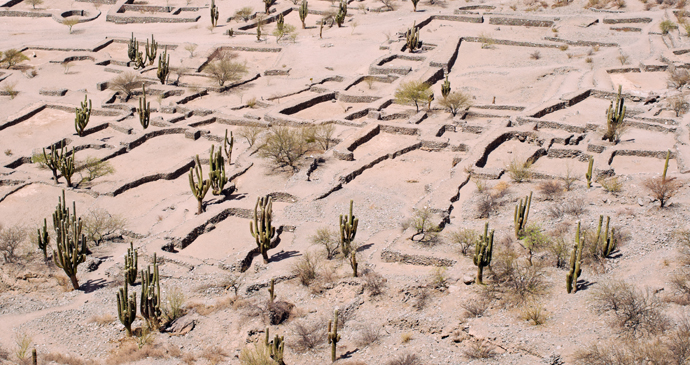 The Ruinas de Quilmes or Diaguita ruins are the remains of the Quilmes peoples’ large urban centre that housed up to 5,000 individuals © Alfredo Cerra, Shutterstock
The Ruinas de Quilmes or Diaguita ruins are the remains of the Quilmes peoples’ large urban centre that housed up to 5,000 individuals © Alfredo Cerra, Shutterstock
The town is halfway to Cafayate from Tucumán on Ruta Provincial 307, which takes a winding and precipitous route; atop one of the passes is a sculpture of the Tafí Indian and the condor representing the strength of nature. There are daily connections to Tucumán (two–three hours, approximately eight daily on an erratic schedule, six on Sunday, 29 pesos) or north to Cafayate and Salta with Aconquija, which also serves Amaicha del Valle, Quilmes, Colalao and Cafayate.
Quilmes ruins
The Quilmes people were a warlike tribe dating back to at least AD1000; they resisted the Incas and endured 130 years of Spanish colonisation. The Ruinas de Quilmes or Diaguita ruins, 5km west of Ruta 40 an hour (46km) south of Cafayate, are the remains of their large urban centre that housed up to 5,000 people. The labyrinthine complex (open: 08.00–19.00 daily; admission 10 pesos) rises up a hillside, which you can climb to the top of, where once only their chief resided.
From here you have a view of the entire valley and the impressive stone wall that reaches out of sight to either end of the complex. For details, contact Sebastián Pastrana (mobile: 0381 15 443 6805). The Quilmes culture was destroyed in 1667, when the Spaniards expelled them from their territory and forced them to walk 1,500km across the desert to Buenos Aires, a destination which none of them reached (although a renowned brewery and a suburb are named after them). It may come as a surprise to learn that the ruins of Quilmes, one of the great archaeological and cultural treasures of the province and the country, were privately owned by the late Hectór Eduardo Cruz, an architect and weaver of traditional textiles.
There is a small museum of sorts but the main function of the building is to sell imitation souvenirs and other regional gifts. There are no interpretative materials in English except for books and brochures that you can purchase. Give yourself a couple of hours to explore the ruins – wear proper sun protection and carry water. The restaurant is very nice, although a bit overpriced, and comfortably cool to escape the intense heat of the sun. Accommodation is available at the Parador Ruinas de Quilmes (tel: 03892 421075, 421004; email: [email protected]).
Tierra del Fuego National Park
Created in 1960 to protect the 63,000ha of the southern tip of the Andes, the sub-Antarctic false beech forests, and the southernmost reach of the Magellanic biogeographical zone, this park holds the distinction of being the southernmost national park in the world. Lenga and the evergreen coihue are the dominant tree species of the cool and damp Magellanic forests. The park encompasses the area from north of Lake Fagnano to the coast of the Beagle Channel, along the border with Chile. Eras of glaciation have etched the landscape with mountain chains and deep valleys. Winds off the sea and the Andes keep the temperatures moderate and rarely below freezing in winter, but rarely above 10°C.
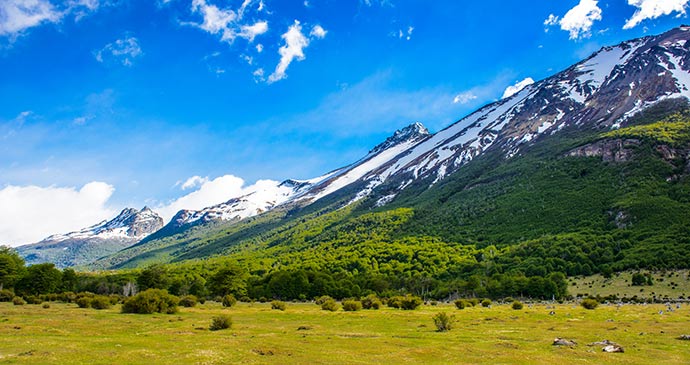 Tierra del Fuego National Park is over 63,000ha in size and has several endemic species © Anton Ivanov, Shutterstock
Tierra del Fuego National Park is over 63,000ha in size and has several endemic species © Anton Ivanov, Shutterstock
The mean precipitation is 700mm per year with no real peak period other than a slight rise in August, and winter snowfall is abundant in the mountains. Peat bogs are common in Tierra del Fuego, occurring when accumulations of dead plant matter such as sphagnum moss and aquatic grasses build up in damp valleys where low temperatures and slow-moving acidic waters prevent decomposition. After several centuries the weight of the upper layers forces oxygen out of the compressed lower layers that thereby form peat. Tierra del Fuego has very limited animal diversity, with only 20 species of mammals and 90 of birds. There are no amphibians. What wildlife there is though is abundant and several species are unique; the Fuegian red fox (Dusicyon culpaeus lycoides) is the best example.
Introduced species take their toll on the island. Most loved and hated is the beaver (Castor canadensis). It has become an attraction with tourists and there are tours specifically to see the beavers’ dams, but they are a menace to the natural ecology and especially the riparian systems. These animals along with rabbits, muskrats and the mainland grey fox were all introduced for supposedly economic reasons for their pelts. There are also rats and other rodents that made their way onto the island from ships, as well as insects and plant species introduced by tourists. Island ecology is fragile, however, and after centuries of a unique evolution based on isolation from mainland species, it cannot quickly adapt to invaders. These introduced species have altered the natural landscape and ecological balance.
Along the coastal shores wildlife is ever-present, whether it be one of the sheldgeese (upland, kelp or ashy headed) or cormorants (you may be fortunate to see the the imperial cormorant up close and glimpse its stunning blue eyes) or any of the numerous coastal birds such as the oystercatcher or the entertaining flightless steamer ducks, churning their legs ferociously to carry them along the water. There are also particular coastal plants such as the sea pink (Armeria spp.). Crustaceans and shellfish are abundant and important economically.
The presence of several tribal groups on the island before the arrival of Europeans goes back some 10,000 years. Ancient middens exist on the beaches of the Beagle Channel and Lago Roca where remains of shells and bones tell of the diet of these peoples. They stayed near the shorelines and used canoes made of the bark of lenga trees for hunting sea lions, collecting molluscs and transporting themselves throughout the area. They were completely integrated into this seemingly hostile environment and clothed themselves in little more than a sea lion pelt; for the most part they were comfortable naked and simply applied the fats and greases from the animals to their skin to repel water.
Vineyards of Mendoza
Being set in the foothills of the Andes and surrounded by vineyards would be publicity enough for the capital city of Mendoza, but there is so much more. By day, it is a great city to walk around, with plentiful trees and flowers in the streets and numerous plazas with markets and street musicians. By night there are theatres and nightclubs to enjoy as well as restaurants with pavement tables where in summer you can sit and watch the passers-by.
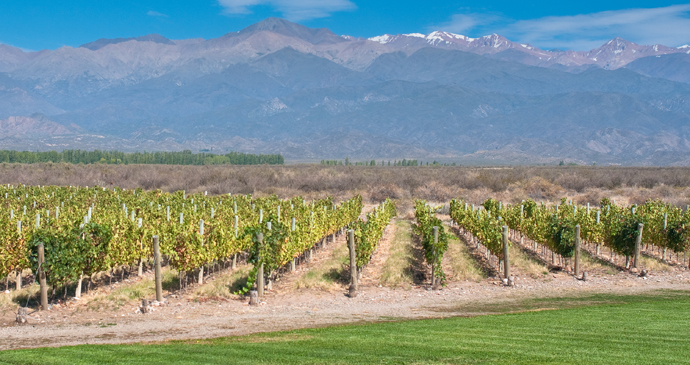
The centre of Mendoza is largely pedestrianised with attractive streets lined with poplars, elm and sycamore (all planted by the city and none of which are native to Argentina) and irrigation channels called acequias. Although Mendoza is an old city, founded in 1561, much of its historic architecture has been lost in earthquakes. The most devastating of these was in 1861, when the city was almost completely destroyed and some 10,000 people were killed. The city was rebuilt with mainly ground-hugging single-storey buildings. The most serious quake in recent times was in 1985, when there were few fatalities but tens of thousands lost their homes.
The Wine Route
The province of Mendoza is the traditional heart of the viticulture industry, with hundreds of wineries nestled in the foothills of the Andes. Specialist tours for wine buffs are operated by Pulp Travel (mendozawinetours.com) and Aymará (www.losvinosdelosandes.com) among others. Many companies offer wine tours by bike, too, such as WineBike; TravelinBike; Mr Hugo (www.mrhugobikes.com); and Maipú Bikes.
Wineries near the city
Bodega Terrazas de los Andes (www.terrazasdelosandes.com.ar) is owned by the Moët Hennessy-Chandon Estates group. They have studied the advantages of various elevations and have found that Syrah gives its best fruit at 800m, in the Cruz de Piedra terraces; Cabernet Sauvignon at 980m, in the Perdriel terraces; Malbec at 1,067m, in the Vistalba terraces; and Chardonnay at 1,200m, in the Tupungato Valley.
Accommodation is available in their own luxury guesthouse with various add-on packages offering you horseriding, cookery lessons, tours, tastings, picnics and shows. Tours are available at 09.30, 11.00, 12.30, 15.00 and 16.00 Monday to Friday, by advance booking. Winery tours with tastings cost from 30 pesos; with lunch, from 160 pesos. A full-day visit to the winery, horseride and picnic costs US$130.
Bodegas Chandon (www.bodegaschandon. com.ar), founded by the famed French house in the late 1950s, produces excellent sparkling wines. Free tours (four per day) are offered in high season.
Wineries in Luján
This town, 15km south of Mendoza, is in the Vistalba Valley as well as various wineries. (It’s not to be confused with the town of Luján outside Buenos Aires, which has a magnificent cathedral.)
Bodega Catena Zapata (www.catenawines.com) has origins that date back to 1902; a fantastic new winery, styled like a Mayan pyramid, opened in 2001. The Malbec is superb. A big company focusing more on the export market than on passing tourists, it does nevertheless offer free tours 10.00–18.00 Monday to Friday (reservation required; book online). However, tastings have to be paid for.
Luigi Bosca’s Wines (www.luigibosca.com.ar) was founded in 1901 by Leoncio Arizu, who had settled in Mendoza in 1890. Vistalba, La Puntilla, Carrodilla and El Paraíso are the four vineyards belonging to Leoncio Arizu.They offer tours at 10.00, 12.00 or 15.00 Monday to Friday, and 11.00 on Saturday, for 25 pesos. Reserve in advance online, requesting English or Spanish.
Bodega Norton (www.norton.com.ar) produces Malbecs and others familiar from your last restaurant’s wine list. They offer regular visits through the day, Monday to Saturday; reserve through the website.
Wineries in Maipú
East of Mendoza city, the region of Maipú is also home to various wineries.
Bodegas y Viñedos López (www.bodegaslopez.com.ar) is a producer of Monchenont, Casona López, Château Vieux, Rincón Famoso, López, Traful and Vasco Viejo. Various tasting arrangements are in place, all requiring advanced booking (easily done online).
The basic 20-minute visit to the vineyard and one-hour visit to the bodega are both free, with English-language tours at 11.30 and 15.30 Monday to Friday. Special tastings are 52 pesos per person, minimum four people; a Guided Vertical Tasting is 150 pesos, minimum four people. Special lunches and dinners can be arranged and wine-tasting courses are offered.
Finca Flichman (www.flichman.com.ar) has been established since 1873. Now it is a modern winery making fine wines largely for export, culminating in the rich, strong Dedicado. Booking is required for tours, which are available 10.00–12.00 and 13.00–16.00 Monday to Saturday.
Familia Zuccardi (www.familiazuccardi.com) was founded in 1968 and has the same owners as Santa Julia and Finca Beltrán. Zuccardi wines are fantastic value, and include organic varieties. You can visit 09.00–17.00 Monday to Saturday; they also offer quad-bike tours of the vineyards followed by tastings.
Bodega La Rural (www.bodegalarural.com.ar) makes the excellent Rutini and Trumpeter wines and has several vineyards around the region. It runs a Museo del Vino here (open: 09.00–13.00 & 14.00–17.00 Mon–Sat).
Related articles
Huw Hennessy shares some of his favourite tracks from across the Americas.
We chat to the race’s runners-up about the highs and lows of their journey.
